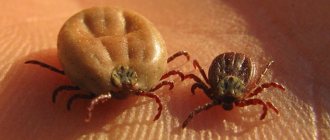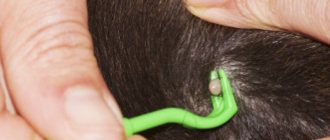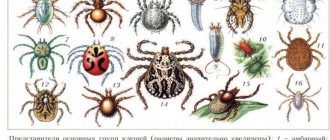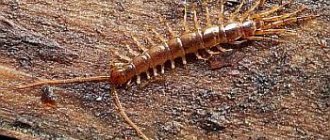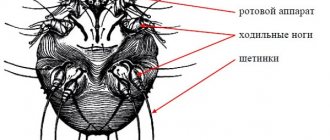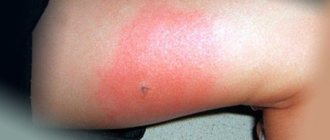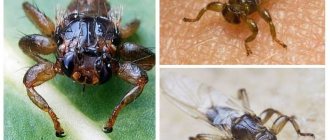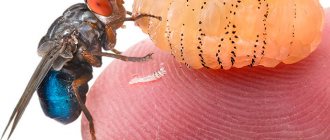— Advertising —
Outdoor recreation, a walk in the park, or just being outside - ticks can be waiting for us everywhere, the bite of which in some cases causes a serious illness. Parasites become active as soon as the spring sun begins to heat up, enough for the air temperature to reach +10°C. But they have an active period twice a year, and from late August to mid-October they resume their activity.
What is the danger of ticks
Being the cause of infections dangerous to human health, they can cause serious diseases, one of which is tick-borne encephalitis, which affects the nervous system; it can lead to severe disability and even death.
However, not every insect is dangerous; only 10-15% of individuals are carriers of the virus. But no less dangerous are borreliosis, granulocytic anaplasmosis, and monocytic ehrlichiosis, which are also caused by ticks. In addition, in different regions, ticks are the cause of infectious diseases such as spotted fever, hemorrhagic fever, typhus, etc.
The causative agent of the disease is transmitted in the first minutes after suction along with saliva, which has an analgesic effect. By the way, as research by Belgian scientists from the Free University of Brussels has shown, the saliva of bloodsuckers has amazing properties: after fixing on the skin, anti-inflammatory substances enter the human body with saliva that can “deceive” the human immune system, substances that prevent clotting: the blood remains liquid. The tick can feed for hours and even days, while it is virtually invisible to the human defense system.
Bitten by a tick - what to do: first aid
If a tick is crawling on you, shake it off immediately, and if it has already attached itself, remove it as soon as possible and store it in a jar with moistened cotton wool or blades of grass to deliver it alive to the laboratory to test for infection.
Treat the wound with an antiseptic. If signs of an allergy are observed - severe redness and swelling of the bite site, immediately give the victim an antiallergic drug. You can purchase the drugs “Zyrtec”, “Suprastin”, “Prednisolone” (spread on the damaged area): the dosage regimen of the drugs is individual. The effect of one tablet is enough for a whole day. These antihistamines are actively used to eliminate allergic reactions. Taking the tablet is not recommended if you are hypersensitive to the components. Hypokalemia, sleep disturbances, flatulence and negative nitrogen balance may develop.
Svetlana Tolstova
Infectious disease specialist, therapist with 15 years of experience in a city clinic.
If the encephalitis virus has entered the human body, the drug Ribonuclease is prescribed for treatment. The medicine is administered 6 times a day intramuscularly, in a hospital setting. The dose is prescribed by the attending physician. The use of Ribonuclease is not recommended for respiratory failure, tuberculosis and bleeding. There is a risk of developing allergic conditions. Do not use the drug without a doctor's prescription!
Where can you find a tick?
These small insects have an excellent sense of smell and can sense their prey from 10-30 meters away. They can wait for a person in tall grass or low bushes. Most often they concentrate on paths or forest paths, they are attracted by the smell of animals and animals that move along them. However, a walk even within the city will not protect you from an attack: often a person, after spending five minutes on the street, discovers an uninvited guest on him.
In addition, a person can become infected without even leaving home. The parasite can be carried by pets, as well as by people - on clothes, with flowers, etc. The existing opinion that ticks “jump” on humans is not true. In fact, a tick clinging to clothing crawls upward. It is found most often on the upper parts of the body; hence the impression that he fell from above.
Where is the bite usually located?
Favorite places on the body for ticks are areas with delicate skin and a developed capillary system: the groin and abdomen, lower back, chest, neck, armpits, ears. An attached tick can stay on the human body from several minutes to several days. Unfortunately, a person does not feel the moment of the bite, since the tick secretes a special substance that prevents pain. Some time after suction, the tick, which has already drunk blood, takes on a rounded shape and a grayish color, and has also significantly increased in size.
What does a tick bite look like?
And although the bite does not cause pain, a local allergic reaction develops; This is what a person pays attention to first of all. At the site of the bite, redness appears, having a round shape, its diameter does not exceed 1 cm. The color can vary from pinkish to dark red, depending on the intensity of the allergic reaction.
In addition to redness, the bite site can be easily recognized by swelling on the skin. Often a bloodsucker can be found attached to the spot on top of the spot. In addition, itching and burning appear - they can bother a person for a week. In some cases, local manifestations on the skin appear after a couple of days. However, with tick-borne typhus, the first sign of a bite will be a blister at the site of infection, which later turns dark red.
Borreliosis
The site of a tick bite that transmits borreliosis looks characteristic; There is also another name for the disease - Lyme disease. In this case, a spot-like erythema appears, the size of which can reach 10-20 cm, although there are cases when the spot in diameter reached 60 cm. After some time, a red border appears along the contour of a round, oval or irregular-shaped spot, the center of the erythema may be white or bluish in color.
Gradually the color becomes less intense and the stain becomes crusty. Then a scar is formed, which disappears without a trace after two weeks. However, after a month and a half, signs of damage to the nervous system, joints, and heart appear.
However, often there are no manifestations at all. Due to the fact that the bite is painless, a person may not notice the insect attack. If there are no pathogens of dangerous diseases in the tick’s saliva, then a person will never know about the incident, not attaching much importance to minor redness, itching or swelling.
How do these parasites definitely not bite?
In all cases, ixodid ticks bite only to suck blood. They never attack a person in self-defense.
Besides:
- A tick bite is never extremely painful, never causes acute throbbing pain, or “burns.” All these signs are characteristic of the bites of arthropods, which try to protect themselves or their nests in this way and scare off a person primarily with the acute pain of a bite (bees, wasps, scorpions, etc.);
- The tick does not bite quickly and does not quickly run away from the bite site. The parasite needs a lot of time to choose the optimal site for suction, and it takes even more time to suck blood. That is, if a minute ago a person examined an area of the body and there was no parasite on it, and then a few minutes later a bite appeared on the same area, but the bloodsucker was not visible, it means that it was definitely not a tick that bit;
- The tick does not seriously injure a person with its bite; blood does not ooze from the wound left by it;
- With rare exceptions, tick bites do not cause a rapid, generalized reaction. During the first 1-2 days after the bite, headaches, fainting, heart problems, nausea and deterioration do not develop. Such symptoms may indeed occur later with the development of an infectious disease transmitted by a tick, but not earlier than after a few days of the incubation period (this usually takes several weeks). If such signs appeared in the first hours after the bite was discovered, then it was not a tick that bit.
On a note
The exception to the latter rule is the bite of the Australian paralysis tick Ixodes holocyclus. Its individuals, at all stages of their development, secrete a toxin in their saliva, leading to paralysis of the limbs in animals and people, as well as symptoms similar to those of polio (even death is possible). The first signs of paralysis after bites of these ticks appear within 6-7 hours. The species Ixodes holocyclus lives only in Australia, and in Eurasia such situations are excluded.
Photo of Ixodes holocyclus paralysis tick:
Another important sign: ticks never bite through clothing, even very thin ones (through tights, for example). Mosquitoes, midges, horseflies, spiders can bite through thin fabrics, wasps and bees can sting, but ticks never stick to the skin through clothing.
It is also useful to read: What to do if you are bitten by a tick
At the same time, under loose clothing - under wide pants, shirts, T-shirts, on the head under a hat - a tick may well bite.
What determines the symptoms after a tick bite?
Each person's reaction to a bite is individual. Some won't even notice, others will experience discomfort for several days. How can you explain such different symptoms?
More intense manifestations occur in children, the elderly, as well as in allergy sufferers or patients suffering from immunodeficiency conditions. By the way, parasites that are not carriers of infection can pose a danger. Tick suction can cause an allergic reaction, sometimes in the form of Quincke's edema. With rapidly developing swelling of the face, lips, and tongue, without the help of doctors, a person is in serious danger.
In addition, the manifestations are influenced by the state of health: in a weakened person the reaction will be more violent. However, the type of tick itself and the duration of its stay on the body are of no small importance. After being bitten by an insect that carries infectious diseases, even the absence of a local reaction on the body does not guarantee that infection has not occurred.
What should you pay attention to after a tick bite?
After infection, the first symptoms usually appear within two weeks. However, the latent period can vary from one day to two months. If up to this point a person has not consulted a doctor, then the presence of the following signs is a reason for an immediate visit to a specialist.
- Temperature increase
- Headache
- Decreased blood pressure and increased heart rate
- Enlarged lymph nodes
- Skin rashes, itching, swelling
- Chills, aching joints
- Difficulty breathing, shortness of breath
- Drowsiness, muscle weakness, increased fatigue
- Lack of appetite, nausea, and even vomiting
- Photophobia
- Sensitivity disturbances in any part of the body, hallucinations, etc.
Thus, the manifestations can be very different, and the difficulty is that the above symptoms may resemble other diseases. Therefore, only a doctor can identify the cause of the ailment. In case of a tick bite, self-medication can lead to serious consequences; if the outcome is unfavorable, paralysis, paresis, speech impairment, etc. are possible.
Signs of infection with tick-borne encephalitis
According to doctors, symptoms of encephalitis are detected after 10-14 days from the moment of tick bite. What to do? There is no need to panic; often elevated body temperature and muscle pain can be a manifestation of the body’s protective psychological response after fear and anxiety.
Once the disease begins, it goes through certain stages:
- Unreasonable and short-lived chills, increased body temperature up to 40 degrees. According to the clinical signs of the formation of encephalitis, this period is more similar to influenza infection.
- After some time, the patient may experience symptoms: nausea and vomiting, attacks of severe headache. At this stage, all symptoms indicate a gastrointestinal disorder.
- After a few days, the patient suddenly develops symptoms of arthritis or arthrosis. The pain in the head goes away and is replaced by aches throughout the body. The patient's movements become very difficult, and breathing problems arise. The skin on the face and body becomes red and swollen, and purulent abscesses appear at the site of the bite.
- Further, the symptoms only worsen, because the infection enters the patient’s circulatory system and begins its destructive work. Delay can lead to death!
If an embedded tick is found on the body, it should be pulled out immediately. You can do this procedure yourself or go to the hospital. Health workers can easily remove it and run a series of tests. Only in laboratory conditions can one accurately determine whether this tick is dangerous. If treatment is necessary, you must unconditionally follow the recommendations and instructions of the attending physician so that the effectiveness of the treatment is maximum.
What to do if you are bitten by a tick?
First of all, if you find an attached tick, remove it immediately. However, this must be done very carefully, without breaking the proboscis, with which the parasite is firmly and deeply strengthened for the entire time of suction. It is unacceptable to crush or pull out a tick with force. Otherwise, infection is inevitable. Today there are special devices on sale; if you live in a disadvantaged region, it makes sense to purchase this device in advance.
How to extract correctly
If it is not available, you can use manicure or medical tweezers. Holding it perpendicular to the bite site, you should carefully grab the body of the parasite, then carefully rotate the tweezers around the axis until the tick is removed. If you don’t have tweezers at hand, you can remove the tick using a regular thread: make a loop, put it around the proboscis near the skin, tighten or twist it in one direction and, using a rotating motion, slightly pulling it up, carefully pull the tick out.
Try not to crush the parasite, as this can infect the wound; meanwhile, the tick may not have had time to excrete anything yet. You can also use two matches; in extreme cases, you can remove the tick with your hands, wrapping it with a piece of bandage. Avoid using oil to remove ticks; even if he crawls out on his own, time will be lost, and such an individual may not be taken for analysis.
After removal, the wound should be treated with a disinfectant: iodine, alcohol, etc. If a black dot still remains, which means the head or proboscis is torn off, then treat the area with iodine. You should not pick at the wound, trying to remove fragments: this can worsen the situation.
After removal, wash your hands thoroughly with soap. Now all that remains is to place the culprit of the incident in a hermetically sealed container and submit it to the laboratory. Remember, a live tick must be delivered for examination within two days. To maintain its viability, you can place a damp cloth in the container. Some laboratories accept dead individuals and even fragments of their bodies for analysis, but the diagnostic accuracy in this case is much lower.
You can also remove a tick at a trauma center or at a clinic at your place of residence. However, when attacked by a tick, it is important to get rid of it quickly, and finding a suitable facility and traveling there may take some time.
What to do after a bite
You can submit the parasite to an accredited laboratory to identify infectious agents. To make sure whether a particular medical institution accepts ticks for analysis, it is better to first contact by phone. The list of institutions can be found on the Internet pages of the territorial administration of Rospotrebnadzor.
During the first two weeks, you should monitor your health status. If one of the above symptoms appears, you should immediately consult a doctor. By the way, today you can undergo examinations that allow you to detect tick-borne infections with high accuracy. For example, the ELISA method can detect specific immunoglobulins produced by the immune system in response to infection. Using PCR, fragments of the genetic material of the infectious agent can be detected in biological material.
What to do if the tick head remains under the skin?
The tick's head may remain under the skin if it is removed carelessly or too quickly. It looks like a small splinter, so some people are negligent about removing it, saying “the tick is dead, it no longer sucks blood, it will fall off on its own,” or they simply don’t notice. But this is not recommended. Remaining under the skin, the tick's proboscis will provoke inflammation and suppuration of the wound. Therefore, do not leave the head or proboscis of the tick under the skin, waiting for them to fall off on their own.
Take a sharp needle disinfected in alcohol and pick up the remaining proboscis and remove it. After a bite, a small wound will remain on the skin, which will heal quickly if the tick was not infectious. Treat the bite site with peroxide, then brilliant green or iodine. If the tick bite area is very itchy, use Fenistil Gel or a similar itching reliever. Try not to scratch the inflamed area to speed up the healing process.
To prevent the head of the tick from remaining under the skin, catch it as close as possible to the suction site
Is it possible to prevent a tick bite?
The likelihood of a tick attack depends on the epidemiological well-being of the region. Every year, Rospotrebnadzor publishes lists of areas endemic for tick-borne encephalitis; unfortunately, such information is not provided for other infections. People whose work involves being in a field or forest, as well as in cases where they will be in places where ticks accumulate, need to be careful.
Vaccination against tick-borne encephalitis
The most reliable method to avoid diseases transmitted by ticks is to get vaccinated against tick-borne encephalitis on time. It is especially recommended for people living or working in an unfavorable tick-infested region or near a forest.
It is recommended to get vaccinated in the last months of autumn. But there are also immediate vaccination options for emergencies. During the warming period, vaccinations can also be done, but after the injection, a person should not be in places where these arthropods live for a month.
The protective effect of the vaccine will occur only after the specified time has elapsed and the entire course has been punctured. Then you can follow the plan and get an injection once every 3 years. If more than 5 years have passed between vaccinations, double vaccination is repeated.
Rule #1 – clothing
When going for a walk, choose appropriate clothing. The shirt or jacket must have long sleeves, and the trousers must be tucked into socks. Don't forget about the hood or scarf, which serves to protect your head. It is better if the items of clothing are light in color: this way the parasite can be easily detected. By the way, it is better to choose clothes with a smooth texture: when a potential victim approaches, the tick climbs to a height of no more than half a meter and waits. His reaction is lightning fast: with paws equipped with suction cups and claws, he reliably clings to clothes.
The tick does not dig into the victim’s body with lightning speed; it travels for several minutes in search of a suitable place. While on a walk, make it a rule to inspect your outer clothing every hour to detect insects in a timely manner. When you return home, also do not forget to examine yourself and your loved ones.
Rule No. 2 – repellents
The range of tick control products available today is incredibly wide. Depending on the active substance they can be divided into:
- deterrents - repellents,
- acaricidal - destroying,
- insecticidal and repellent - with a combined effect.
The protective repellent can be applied to areas of the body or clothing. Avoiding contact, the tick will try to crawl away. The drugs are available in the form of aerosols, creams, lotions: Raptor, OFF, DEET, Ultraton and many others. etc. There are also less toxic products for children: Fthalar, OFF-children, Kamarant, etc.
Acaricides are based on a drug that has a nerve-paralytic effect on ticks; upon contact with treated clothing, the tick simply disappears. However, these products are not intended for use on the skin as they are toxic. By the way, clothing processing is not carried out on humans. It is laid out, processed and only after drying is put on. As a rule, the protective properties last up to two weeks.
There are also preparations intended for treating areas or premises. If you are planning a picnic in nature, then you can take care of your safety in advance by spraying a pre-planned place.
What infections can you get from a tick?
A tick bite can cause infection:
- tick-borne encephalitis,
- tick-borne borreliosis (Lyme disease),
- tularemia,
- babesiosis,
- monocytic ehrlichiosis,
- tick-borne typhus,
- Q fever,
- spotted fever,
- hemorrhagic fevers, etc.
In Russia, the most common diseases are borreliosis and tick-borne encephalitis. The peak incidence is observed in spring and summer. Other infections are much less common. Table 1 summarizes some of the infections listed.
Key warning signs associated with tick-borne infections include:
- drowsiness and weakness,
- temperature increase,
- chills,
- headache,
- pain in joints and muscles.
Tick-borne encephalitis is characterized by a fear of light and muscle weakness, and borreliosis is characterized by tension in the neck muscles, facial paralysis, inflammation of the joints and lymph nodes. Another telltale symptom of Lyme disease is erythema migrans. This is a red spot at the site of a tick bite, spreading out into a ring on the skin.
With tularemia and ehrlichiosis, digestive disorders (nausea, vomiting) are often observed, and babesiosis and Q fever may be accompanied by a dry cough.
What to do if you notice symptoms
If you notice any suspicious symptoms, you should immediately consult a doctor. Currently, the effectiveness of post-exposure prophylaxis has been proven only for borreliosis (single dose of doxycycline), however, timely treatment helps to avoid many complications.
What happens if you don’t see a doctor: complications
Ignoring symptoms can lead to dire consequences, including death. In Table 1 we have listed the main complications associated with tick-borne diseases.
| Table 1. Complications caused by tick-borne infections. | |
| Disease | Complications |
| Tick-borne encephalitis | Inflammation of the brain substance, breathing disorders, damage to the circulatory system, mental disorders, paralysis, muscle atrophy, death |
| Lyme disease (borreliosis) | Arthritis, nervous system complications |
| Tularemia | With a generalized form of the course - death |
| Babesiosis | Anemia, acute renal failure |
| Ehrlichiosis | Aseptic meningitis, facial nerve paresis, liver damage, acute renal failure, toxic shock |
| Q fever | Pneumonia, tracheobronchitis |
If you notice any of the symptoms listed in the table, you should immediately consult a doctor. Currently, the effectiveness of post-exposure prophylaxis has been proven only for borreliosis (single dose of doxycycline), however, timely treatment helps to avoid many complications.
Rule No. 3 – vaccination
Preventative vaccines are available for some infections (but not all). Primary vaccination is possible from the first year of a baby’s life, then at any age in the absence of contraindications. You can get vaccinated by visiting a medical facility. However, it should be noted that the vaccination course should be completed 2 weeks before a possible encounter with ticks.
If you have been vaccinated against tick-borne encephalitis, does this mean that ticks are no longer dangerous? Vaccination against encephalitis protects 95%, but only against this infection, but in no case against all diseases carried by parasites. Therefore, even if vaccinated, precautions should be taken.
What should you do if you are bitten by a tick, but there is no vaccination? For unvaccinated patients, immunoglobulin administration is recommended, but this must be done in the first three days after the bite. If it is impossible to use immunoglobulin (lost time, contraindications, cost), antiviral agents may be recommended, but their effectiveness is not one hundred percent.
Treatment of tick-borne encephalitis
If the diagnosis is confirmed, the doctor recommends comprehensive treatment to the victim. In the acute stage, strict bed rest with intensive therapy is prescribed, which helps reduce the amount of toxins in the body and weaken the active virus.
The victim is also injected intramuscularly with the drug “Gammaglobulin”. The sooner this serum begins to act, the faster the patient will experience improvements. The effect of the drug lasts for a day, after which the body temperature normalizes, the signs of encephalitis and meningitis decrease, and then completely disappear. To alleviate the signs of poisoning, you need to introduce fluid to restore electrolyte balance, and also start taking glucocorticoids.
Do not use the drug under any circumstances unless prescribed by a specialist!
